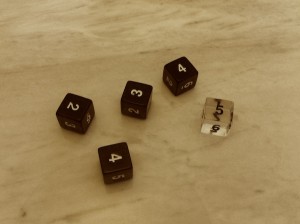 The Carcosa supplement introduces a rule where hit dice are not rolled until combat begins. The hit die size is also determined randomly. At the start of an encounter, HD are rolled and left in front of each player. Damage is then inflicted upon the die with highest face value first. For example, a character with three rolled HD of 5, 4, and 2 takes damage to the 5 die first. If a die is reduced to zero, it is removed entirely from the character’s pool and only returned in the case of healing. If that character only takes (say) 3 damage during an encounter, all three HD are retained, and there is no persistent damage. I have used this system, and though it does take a bit getting used to, it works in practice more smoothly than it reads.
The Carcosa supplement introduces a rule where hit dice are not rolled until combat begins. The hit die size is also determined randomly. At the start of an encounter, HD are rolled and left in front of each player. Damage is then inflicted upon the die with highest face value first. For example, a character with three rolled HD of 5, 4, and 2 takes damage to the 5 die first. If a die is reduced to zero, it is removed entirely from the character’s pool and only returned in the case of healing. If that character only takes (say) 3 damage during an encounter, all three HD are retained, and there is no persistent damage. I have used this system, and though it does take a bit getting used to, it works in practice more smoothly than it reads.
This approach has a number of properties that may be disentangled if desired. First, determining the die size randomly increases the uncertainty of combat. Though higher level characters are on average tougher than lower level characters, when combat starts you may be rolling four-sided dice for HP, twelve-sided dice, or something else. Second, rolling a handful of dice and letting them sit in front of you eases the tracking of damage, as there is no HP tally. You just have a max HD value written on your character sheet, and a remaining pool of dice in front of you.
I think the second property would work well without the first (that is, rolling the HD at the beginning of combat, but not determining the HD size randomly). It would be especially convenient using OD&D style all six-sided HD, given the ubiquity of six-siders. How to handle bonus HP would need to be determined (the second term in an HD expression such as 1+1 or the bonus from constitution). The most satisfactory method would probably be to have a series of static “bonus” hit dice to represent those extra HP which would not be rolled. For example, assuming values from Men & Magic, a fifth level fighter with an exceptional constitution has 5+1 HD and +5 HP. This could be represented as 5d6 rolled plus one die set down with a “6” value. Handling penalties seems more tedious, and I cannot think of a better system right now than needing to adjust each die downward after rolling them. The B/X bonus scale of -3 to +3 also would require more bonus dice, with a mid-level high-constitution character having several “static” HD worth of bonuses, but it seems like that would not be overly cumbersome.
Using a system like this also opens up the possibility of using hit dice as other sorts of resources. For some ideas along those lines, see:
Using HD as resources could require re-rolling them, removing them from the pool entirely, only removing them in the case of rolls less than (or greater than) the current rolled face value, or any other number of ways to modulate potential die removal.
HP determination could also be deferred until damage is rolled, as described here:
Rereading that post, however, I think it is probably less immediately approachable than the kind of modified Carcosa die system outlined here.

What if bonuses and penalties were handled as additional dice, but you had to discard the lowest and highest, respectively. So a 4HD character with a -1 Con modifier rolls 5 dice for 2, 3, 3, 4, 5 and has to discard the 5 for this encounter. If it was +1 they would discard the 2.
If the range was -3/+3 that’s not too many additional dice, and it avoids subtraction or adjustments for the penalties.
Clearly I like this idea.
@George
Yes! That extra dice and drop highest/lowest is a good approach. Certainly better than what I have in the post. I’m surprised I didn’t think of it, as I use it in some other places.
Pingback: Dice Clocks |